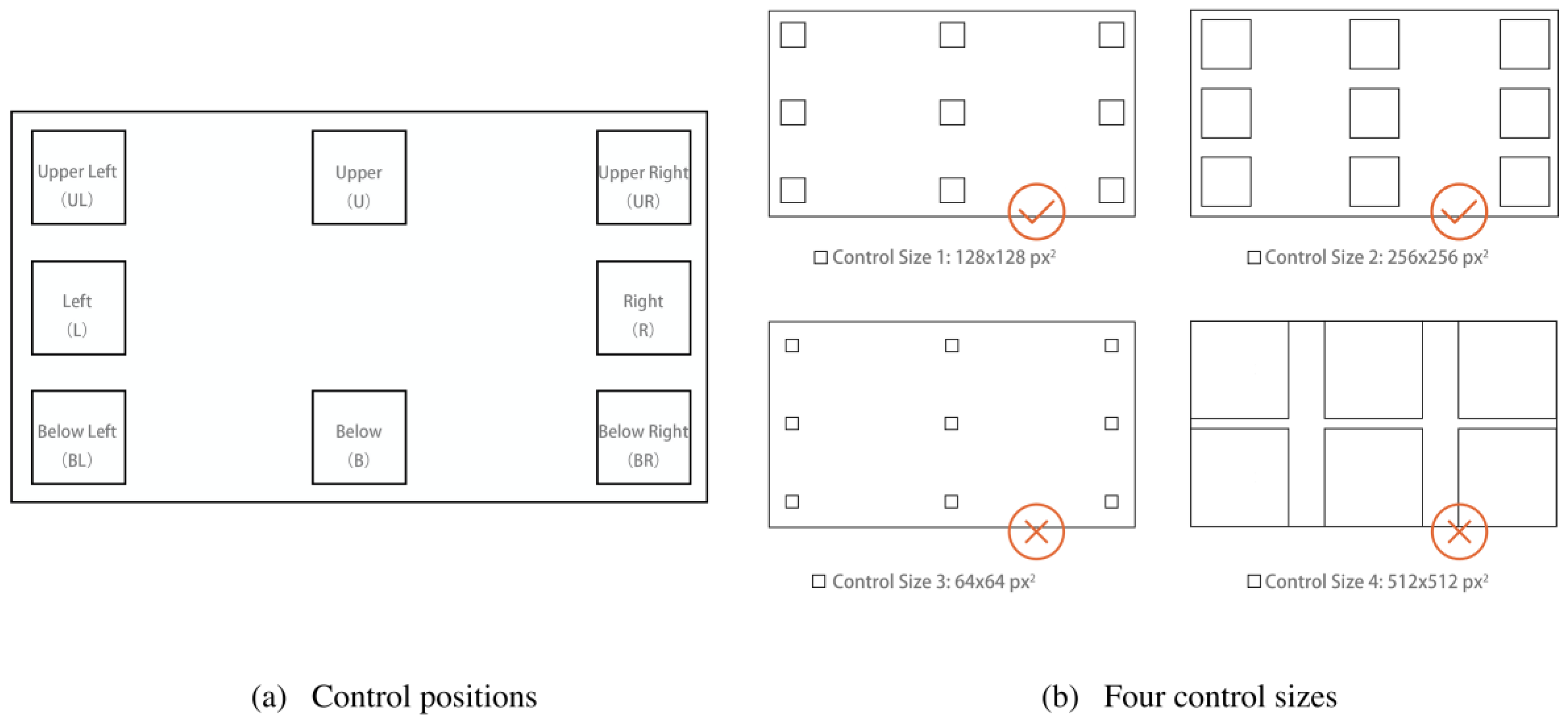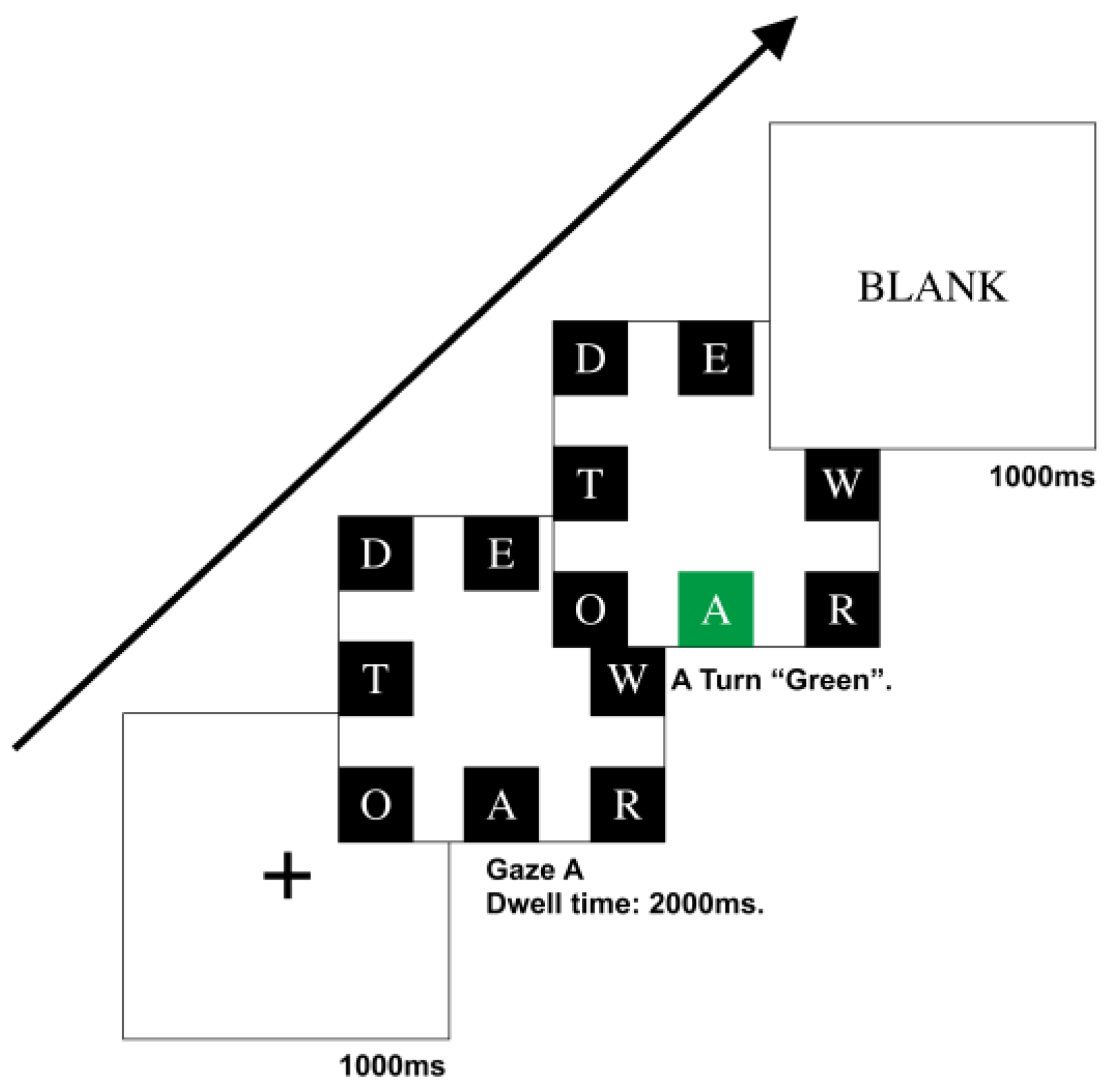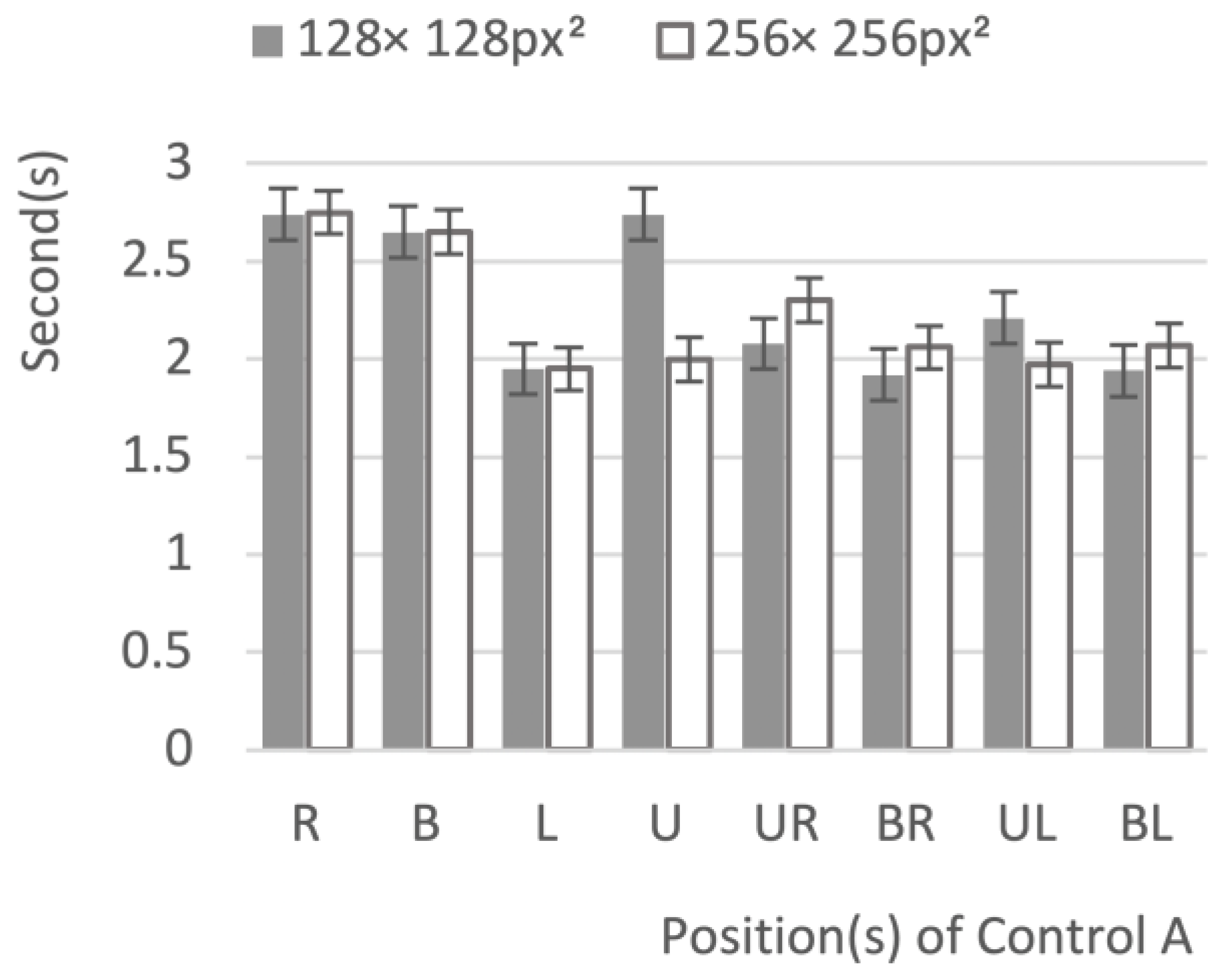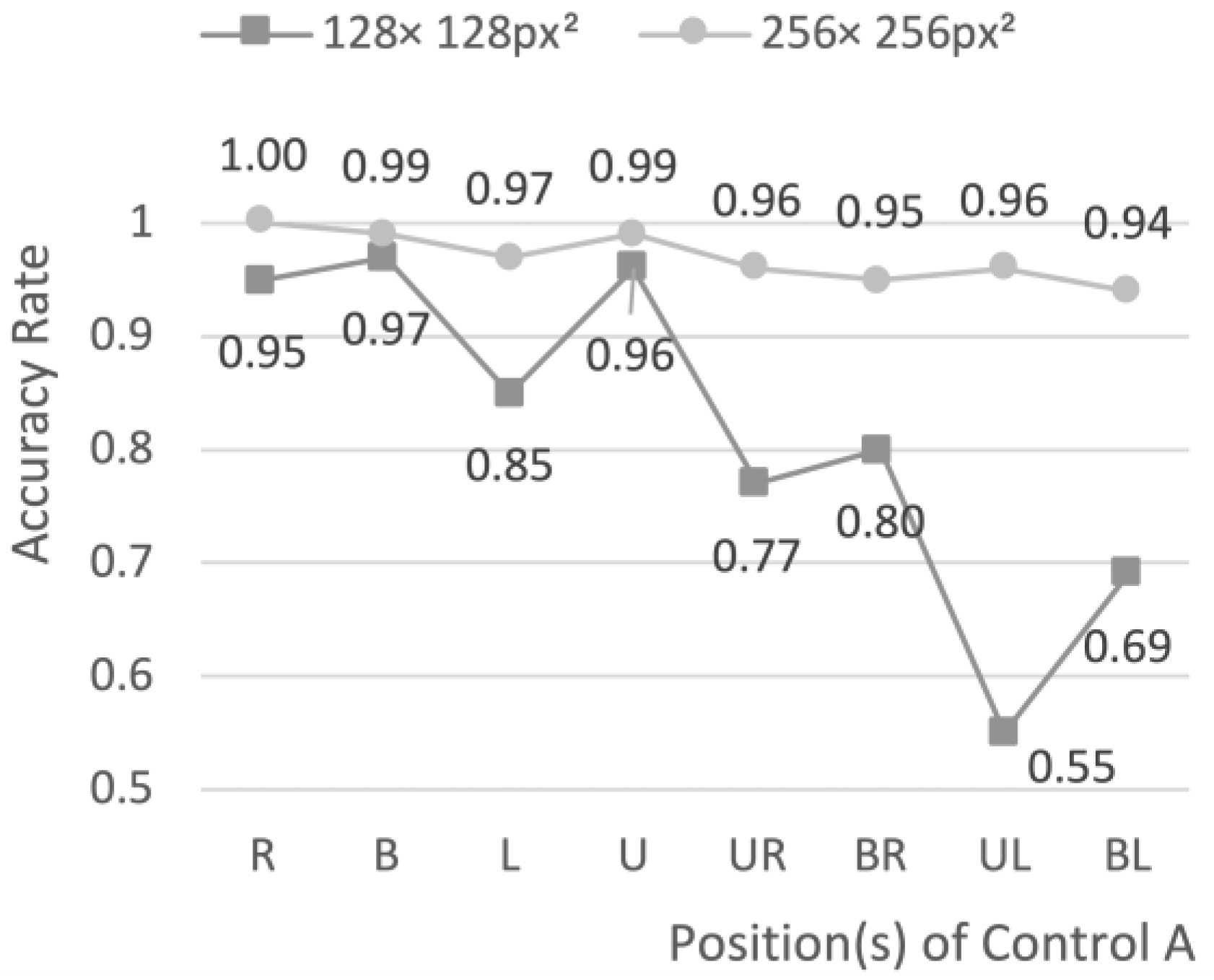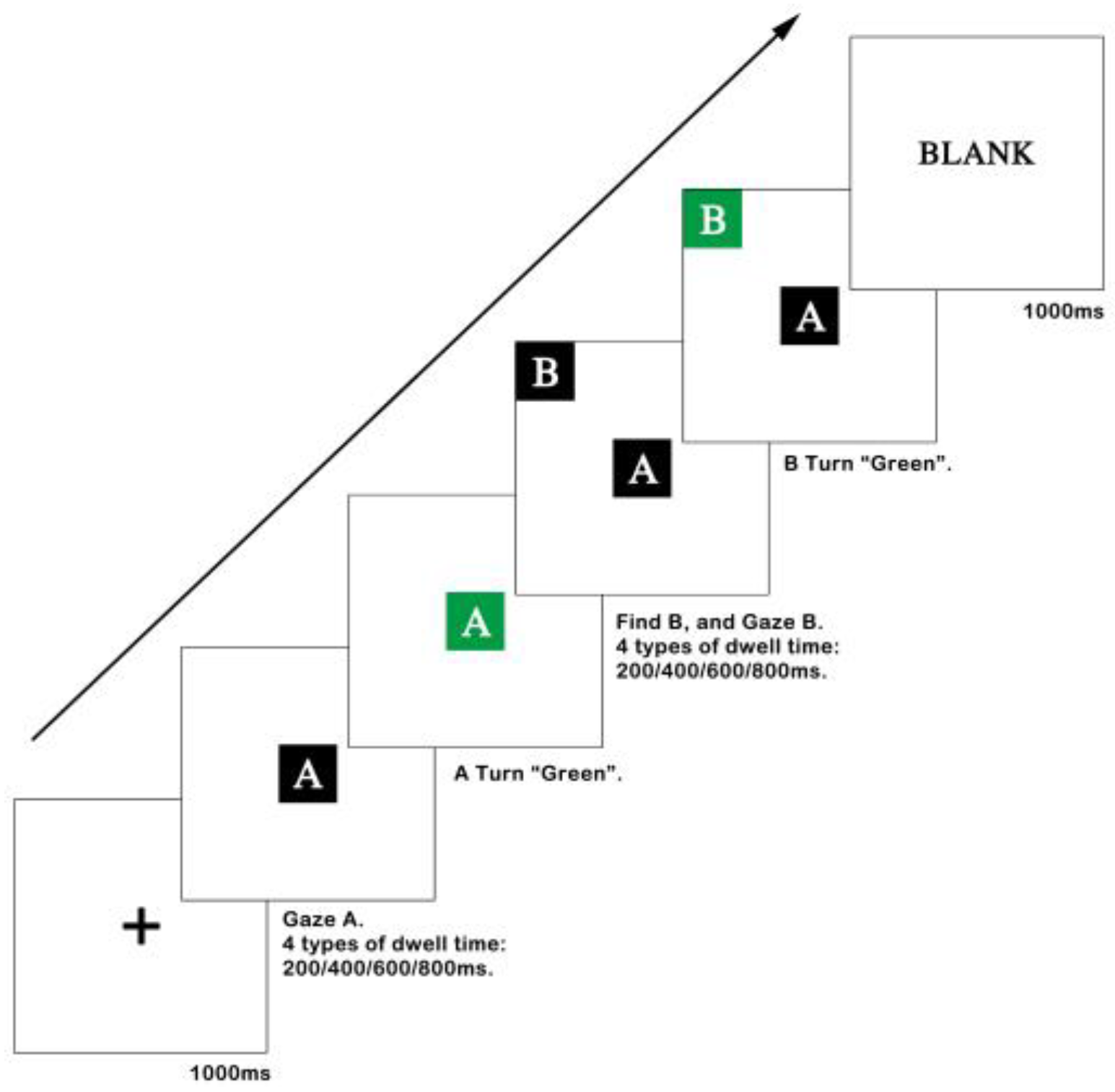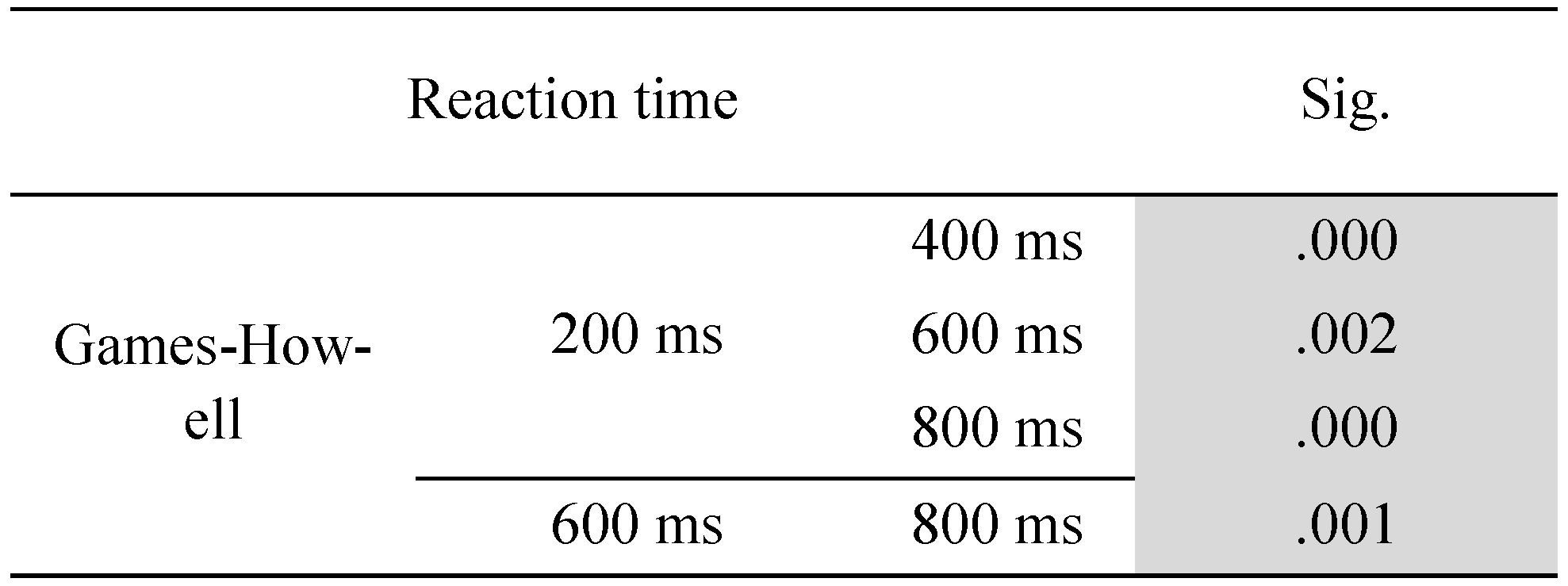Introduction
The Eye–Computer Interaction (ECI) is an interactive method of controlling a computer or equipment by eye movements. An eye tracker is used to capture the user’s line of sight data and identify the real-time position and trajectory of the gaze point. The ECI input commands include fixation, gaze gesture, blink, saccade, and smooth pursuit [
1]. ECI has become the main control mode in the fields of head mounted displays (HMD) aiming system [
2], and Artificial Intelligence [
3], and it can also help patients with amyotrophic lateral sclerosis, hemiplegia, and pediatric cerebral palsy to communicate without obstacles. As the first interactive entrance, the user interface is one of the most important components in the ECI system, and all the ECI input commands are directly related to it. A good ECI interface design can improve user manipulation performance. Both, Windows and IOS operation systems have interface design specifications and standards [
4,
5], but they are not entirely practical for the ECI system. There are two universal problems with the ECI system: “Midas touch” and “low spatial accuracy”. On the one hand, the ECI system can-not accurately distinguish whether the user is looking at a control for interaction or only getting information owing to the “Midas touch” [
6,
7]. As shown in
Figure 1-a, the user’s original intention was to glance at A to get information but not trigger A; however, the system feedback result showed that A was triggered. On the other hand, “low spatial accuracy” resulted in a large deviation between the eye gaze position and the actual target control position, which led to a large probability of accidentally touching adjacent controls. As shown in
Figure 1-b, the user planned to gaze at A and trigger it, but adjacent control B was triggered instead.
In order to address these two questions, scholars proposed solutions in terms of the eye movement index [
8,
9], the positioning calibration algorithm [
10,
11,
12,
13,
14,
15], and multi-channels [
16,
17]. However, these methods required a higher hardware configuration and algorithm accuracy, which brought new problems such as visual fatigue [
18,
19] and a poor interaction experience [
20,
21]. Therefore, in the interface design of the eye control system, it remains to be determined what kind of interactive feedback mode brings the highest interaction efficiency. In addition, we need to find out how large the interaction area is when the recognition rate is the highest? These are the two core issues of this research. The interaction efficiency can be evaluated comprehensively by the reaction time and user workload, and the recognition rate can be obtained by the accuracy rate or error rate.
Interactive feedback mainly involves eye-triggering movements and the dwell time. The main forms of eyetriggering movements are fixation, gaze gesture, blink, and closure, among which fixation is the most basic, widespread, and direct mode, so this research chose gaze as the triggering movement.
The interaction range mainly involves the size and location distribution of the functional control. The size refers to the spatial area of the control. The location distribution is mainly reflected in the saccade orientation or the speed of sight-lines’ moving from the current triggering control to the next control. The faster the speed is, the greater the location advantage of the next control. The research on the best interactive feedback form and interactive range could reduce the Midas touch and improve the spatial accuracy to a certain extent.
This research mainly investigated the optimal gazetriggering dwell time and size of functional controls. The gaze interaction basic model of the ECI system can be used to describe the process intuitively, as shown in
Figure 2. In Step 1, an individual gazes at module A and triggers it; in Step 2, a visual search is conducted to find target module B, and ignore other distractors; and in Step 3, an individual gazes at module B and triggers it. Steps 1 and 3 mainly involve the gaze-triggering dwell time, and Step 2 refers to the saccade orientation at the fastest saccade speed in different spatial positions. In Step 3, the black square is the functional control for triggering and gray is used in the non-triggering situation.
Experimental Series 1
Experimental Series 1 was used as the pre-experiment. By recording the reaction time and accuracy rate under different control sizes, the optimal control size was screened, which paved the way for the formal experiment. The control size was set to two levels, and the position of control in the interface was set to eight levels. Experimental Series 1 adopted a single-factor, two-level experimental design.
There were 10 (repetitions) × 8 (positions) × 2 (128 × 128px2, 256 × 256px2) × 20 (participants), giving a total of 3200 trials in the whole of Experimental Series 1. For each single level (128 × 128px2, 256 × 256px2), 1600 sets of data were recorded. Each participant needed to complete 10 (repetitions) × 8 (positions) × 2 (levels) for a total of 160 trials, which took approximately 10 minutes.
Participants
Twenty right-handed volunteers participated in Experimental Series 1 and 2. Their ages ranged from 21 to 25, the mean age was 23.1, and the standard deviation was 1.5. They were all undergraduate or postgraduate students from Southeast University. All participants were physically and mentally healthy, had no history of mental illness, and had normal or corrected vision without astigmatism. All of them had experience with using the Tobii eye tracker. The study protocol had been approved by the Southeast University Ethics Committee.
Equipment
The computer system used was Windows 10, and the screen size was 1920 × 1080px2. The Tobii X2-30 Eye tracker is an eye movement tracker device with a 30 Hz sampling rate. It is small in size and was fixed at the bottom of the screen for the experiment. The device was used to get participants’ eye movement data during the process. The experimental platform was imported into the Tobii SDK installation package through Unity6.0 and compiled using C#.
Experimental stimuli
The dependent variables were the reaction time and accuracy rate. The reaction time was directly output by the eye tracker and represented by ta, which referred to the length of time from the beginning of the trial to the trigger of control A. The accuracy rate was calculated as (number of tasks - number of failed tasks)/number of interfaces. Failed tasks included unintended activations and timeouts. When the residence time of a trial exceeded 10 seconds, the system counted it as a timeout automatically.
Procedure of Experimental Series 1
Participants were told to sit in front of the screen, with their eyes approximately 640 mm from the screen. The angle between the sight and the screen was 27° horizontally and 17° vertically. Experimental Series 1 trial began with a black cross focal point with a white background in the center of the screen for 1000 ms. Then, controls of different sizes with eight white letters on black backgrounds were displayed in the eight different directions of the white background screen. The eight different blocks used in each trial were random but contained control A each time. Participants were asked to find control A and gaze at it for 2000 ms until it turned green (#009944). When participants gazed at other controls but not control A, the related control turned red, which meant that participants were making wrong decisions. As participants finished the task with the right decision or could not finish in 15 seconds, a white blank display subsequently appeared for 1000 ms. Visual persistence was eliminated, and participants could take a rest as well. The procedure of Experimental Series 1 is depicted in
Figure 4.
All levels of independent variables were included in each round of experiments, and each level had one trial in a total of 40 rounds. Each participant needed to finish two rounds of experiments. After the first round of experiments was completed, there was a rest period. Trials appeared randomly.
Data analysis of Experimental Series 1
- (1)
Reaction time
In the data preprocessing, 20 data points had been removed corresponding to timeout failure and accidental fixation, the average time taken for task completion is shown in
Figure 5.
The graph shows that the reaction time of both 256 × 256px2 and 128 × 128 px2 was around 2 seconds. The unequal variance analysis of the independent samples T tests was used for data analysis. The results shows that there was no significant difference between the reaction time at the two size levels (p = 0.057, p > 0.05), that is, reaction time could not be used to select the optimal control size.
- (2)
Accuracy rate
An One Way ANOVA analysis was performed on the accuracy rate data (
Figure 6). The analysis suggested that there is a significant difference in the accuracy rate under different control sizes. The accuracy rate of the control with a size of 256 × 256px
2 (0.97) was significantly higher than that of the control with a size of 128 × 128px
2 (0.82) (F = 3.97, p < 0.001). Therefore, 256 × 256px
2 was chosen as the control size.
Discussion of Experimental Series 1
In Experimental Series 1, the size levels were 128 × 128px
2 (3.36° × 3.36°) and 256 × 256px
2 (6.63° × 6.63°), respectively. Two dependent variables were adopted to select the optimal size: reaction time and accuracy rate. The average reaction time under levels of 128 × 128px
2 and 256 × 256px
2 were 2.05 and 2.38 s, respectively. According to the variance analysis, the size level had no significant influence on the reaction time. The short review above shows that the reaction time cannot be used as an effective indicator in this experiment. However, as can be seen from
Figure 5, the reaction time at level 128 × 128px
2 was longer than that at level 256 × 256px
2 in most cases. At the same time, there were certain differences in the response for different control positions. However, the impact of control positions on the efficiency is not discussed in this research.
Itakura and Sakamoto [
25] built experimental interfaces with two different control sizes, with the width of the controls being 4° and 6°, respectively. In their study, the accuracy rate was calculated by deviation. If the deviation in one gaze was greater than 2°, it was considered a triggering failure. Finally, the accuracy of the interfaces was 96.7% and 88%, in which the control size made the difference. In Experimental Series 1, the accuracy rate of the 256 × 256px
2 size was significantly higher than that of the 128 × 128px
2 size (p < 0.05), which was consistent with the conclusion of Itakura et al. and was also consistent with the interaction suggestions proposed by Chitty [
26]: in the ECI system, control sizes should be as large as possible, while the information capacity and fault tolerance should be also considered.
In addition, the less accurate areas in the interface were at the lower right corner, and the distribution area of the viewpoint before fitting was 225×183px
2 [
27]. In Experimental Series 1, all eight controls were located at the edge of the screen. Compared with the controls located in the center, the gaze accuracy of the controls at the lower edge and right edge was significantly reduced (p < 0.05), maybe this is related to the precision of the eye tracking device [
28]. In order to ensure the accuracy and efficiency of the gaze input, the optimal size of the control located at the edge of the screen should be slightly larger. This conclusion supports the conclusion of experiment 1.
Fitz’s law for ECI is as follows: when human eyes scan an object, the viewpoint will first move to the direction close to the target by a large distance and then be adjusted slowly and slightly through a small distance, before being positioned at the target [
29]. The first stage of the saccade is quick. However, when the control is relatively small, the slow adjustment in second stage will last longer, which can affect the reaction time to some extent. Murata, Konishi, Moriwaka, and Fukunaga [
30] verified the influences of the shape, area, and position of gaze-input controls on the reaction time (pointing time) in the ECI system and how it fits with the modified Fitz’s law model. Ware and Mikaelian [
31] also fitted Fitz’s law to the reaction time model and obtained a relatively ideal result:
Pt refers to the reaction time,
d is the distance between control B and the center of control A,
s is the area of control B,
a and
b are constants, and log
2(
d/
s + 1) is defined as the difficulty. In the study of Ware and Mikaelian [
31], the data of square controls fit the modified Fitz’s law best. This suggested that the reaction time of square controls would decrease significantly with the increase of control size. This is another main reason why we chose square as stimulus material (the first reason had been mentioned in the part of “Theoretic foundation of shapes”).
The purpose of Experimental Series 1 is to screen the optimal control size. In order to get the optimum gaze-triggering dwell time of optimal control size, Experimental Series 2 was conducted.
Experimental Series 2
Experimental Series 2 was used as the Main Experiment to investigate the optimum gaze-triggering dwell time by conducting a comprehensive evaluation of the accuracy rate, reaction time, and NASA-TLX (Task Load Index). According to the results of Experimental Series 1, control sizes A and B were set to 256 × 256px2. The purpose of setting control A was to make participants’ eyes start from the center of the screen uniformly to eliminate the original error. Control B was used as the interactive control. In this experiment, a single factor four-level design was adopted. Since the design of Experimental Series 2 was based on the conclusion of Experimental Series 1, same participants completed the two experiments at different time intervals of one week. The participants and equipment used in Experimental Series 2 were same as those used in Experimental Series 1.
There were 10 (repetitions) × 8 (eight positions) × 4 (200, 400, 600, and 800 ms) ×20 (participants), giving a total of 6400 trials in the whole of Experimental Series 2. For each single level (200, 400, 600, and 800 ms), 1600 sets of experimental data were recorded. Each subject needed to complete 10 (repetitions) ×8 (positions) ×4 (levels), giving a total of 320 trials, which took approximately 20 minutes.
Experimental stimuli
Experimental Series 2 adopted a single factor fourlevel experimental design. The independent variable was set as the dwell time, which was the within-subject factor. The reaction time, accuracy rate, and subjective evaluation were selected as the criteria to select the dwell time. The reaction time refers to the time taken from seeing control B to pressing control B to react successfully. Each trial consisted of four periods:
ta: The time from the appearance of the interface to the trigger of control A;
tb: The time from the appearance of the interface to the trigger of control B;
tt: The time required for the control to be triggered, which was 200, 400, 600, or 800 ms respectively. It was equal to the level of triggering time foreach group.
tr: Reaction time.
t
a and t
b were the original data output by the eye tracker. A timeline of the duration of each section is shown in
Figure 7. The reaction time equals the total time minus the dwell time:
Procedure of Experimental Series 2
The process was divided into four steps. The first and last steps were consistent with Experimental Series 1. In the second step, control A with a black background was displayed in the center of the white background screen. Participants needed to gaze at control A for a dwell time of 200, 400, 600, or 800 ms. When participants gazed at control A in the required time, control A would turn green (#009944), which meant that control A was triggered. In the third step, control B with a black background was displayed in one of eight directions on the screen in a random order, and control A turned the original black color again. Meanwhile, participants needed to find control B and gaze at control B for a dwell time of 200, 400, 600, or 800 ms. In the fifth step, control B turned green.
All levels of independent variables were included in each round of experiments. Trials appeared randomly. Each participant needed to finish two rounds of experiments. After the first round of experiments was completed, there was a rest period. The procedure used for Experimental Series 2 is depicted in
Figure 8.
Data analysis of Experimental Series 2
- (1)
Reaction time
In the data preprocessing, 24 data points had been removed corresponding to timeout failure and accidental fixation. In order to verify the specific impacts of different dwell times on the reaction time, SPSS was used for the following analysis.
A one-way analysis of variance was conducted on the dwell time, and it was found that the dwell time had a significant effect on the reaction time (p = 0, p < 0.05). The mean and standard deviation of the reaction time were then plotted as a boxplot (
Figure 9). The average reaction time at four trigger time levels was represented by
.
r200 = 0.656 s,
r400 = 0.456 s,
r600 = 0.362 s, and
r800 = 0.680 s, respectively. The comparison shows that
r600 was relatively small. However, the variance in the dwell time at 600 ms was 0.2, which was greater than the variance of the other three levels (0.002, 0.002, and 0.006). This indicates that at a level of 600 ms, the individual difference in dwell time between participants was large, which made the dwell time increase greatly between 0.55 and 1.1 s.
In order to further verify the inter-group differences in reaction time between the four levels, a post-hoc comparison was conducted. Since the variances of the four groups of data were different, Games–Howell analysis method was adopted without assuming homogeneity of variances. In this method, when p is less than 0.05, there is a significant difference between the levels. The results are shown in Tab.1, where p values are given. As can be seen from the table, among the four dwell time levels:
There were significant differences between the 200 ms and 400 ms groups (p = 0, p < 0.05);
There were significant differences between the 200 ms and 600 ms groups (p = 0.002, p < 0.05);
There were significant differences between the 200 ms and 800 ms groups (p = 0, p < 0.05).
That is, in Experiment Series 2, levels with longer reaction times were the 200 ms and 800 ms conditions, and levels with shorter reaction times were the 400 ms and 600 ms groups. After comparing the average values, the optimal dwell time level of the control under the experimental conditions was selected to be 600 ms.
- (2)
Accuracy rate
The average accuracy rate was represented by . By calculation, the value of at the four dwell time levels was r200 = 100%, r400 = 100%, r600 = 97.5%, and r800 = 98.1%, respectively—all basically above 95%. Based on the analysis of the variance of data, it was found that the dwell time had no significant influence on the accuracy rate of the task (p = 0.31, p > 0.05), that is, the accuracy rate had no obvious influence on the dwell time.
NASA-TLX Evaluation
Subjective evaluation is an important criterion in interface design. In order to verify the results of data analysis and also evaluate the usability of the interface, for Experimental Series 2, the NASA-TLX scale [
35] was used to carry out the subjective evaluation of the task load under different dwell time levels of the controls. Mental Demand (MD), Physical Demand (PD), Temporal Demand (TD), Operational Performance (OP), Effort (EF), and Frustration (FR) were used in the scale.
After confirming the questionnaire was matched with the experimental level by participant, each participant needed to fill out one questionnaire based on NASA-TLX scale for the related dwell time level in real time, four questionnaires in total. When each round experiment is over, Participants were asked to report their subjective feelings and feedbacks. After finishing the experiment, the six indicators were scored by 20 participants according to their experimental experience. In the score setting, full score is 100, a step length is 5, there are 20 scoring values in total. Participants needed to compare the above six indicators in pairs and selected the ones with a greater impact on the evaluation. The selected frequency of each indicator was counted to calculate the weight of it. The proportion of the corresponding frequency of each indicator in the total number of times was the weight of the indicator. Finally, the weighted average scores of six indicators were used to calculate the average load values, which were compared to select a level with a lower load value. Six indicators in the scale were divided in pairs, which were divided into 15 groups.
The result shows that the weight of Mental Demand (MD) was 0.01, that of Physical Demand (PD) was 0.33, that of Temporal Demand (TD) was 0.13, that of Operational Performance (OP) was 0.20, that of Effort (EF) was 0.29, and that of Frustration (FR) was 0.04. After summarizing the scores, the average load value of the subject could be obtained by the weighted average scores of each indicator (
Figure 10).
Through calculation, it was determined that when the dwell time was 600 ms, the average load value of the participants was the lowest, 28.55, far lower than the average load value when the dwell time was 400 ms (40.05) or 800 ms (51.02), and slightly lower than the average load value under dwell time of 200 ms (31.87).
Discussion of Experimental Series 2
The accuracy rate at the four dwell time levels was basically above 97%. The possible reason for this is that the tasks were not difficult, which caused a “ceiling effect”. That could have meant that the accuracy rate had no distinguishing effect on the experiment. A similar pattern of results was obtained in the study by Itakura and Sakamoto [
25]. They suggested that with a control width of 6°, the accuracy rate of the gaze trigger was basically higher than 95%, and there was no position discrimination. After analysis, the possible reasons were determined to be as follows:
In Experimental Series 2, the efficiency of the interface reached a high level by selecting factors such as size and shape. Therefore, most of the participants were able to complete the experimental task, so the accuracy rate had no differentiation effect. The same participants joined in two experiments, so experiments were designed as single post-test groups, that means participants were trained to operate skillfully after Experiment 1, which would have caused a certain amount of interference in the accuracy of the results. To some extent, the experimental results are influenced by the learning effect.
According to the traditional WIMP (Window/Icon/Menu/Pointing device) interface specification while considering the instability of sight, the trigger was set to require one click instead of a double-click. Each trial included two one-click trigger tasks with a single type of trigger. The size, color, and shape of the controls in the interface was the same, without distinction. Therefore, the overall difficulty was relatively lower, which led to a high accuracy rate.
As for the dwell time, the data revealed a significant effect on the reaction time (p = 0, p < 0.05). Among them, the difference between groups at levels of 400 and 600 ms was relatively small and that between groups at levels of 200 and 800 ms was also relatively small. In addition, the average dwell time at the level of 600 ms was small (0.362 s). Finally, the optimal dwell time was selected to be 600ms. Zhang et al. [
13] also found that during gaze-input interaction, the dwell time had a significant impact on the reaction time and task load. Finally, Zhang suggested that the dwell time under the level of 600 ms was the shortest with the least error.
When the dwell time is set to be relatively short, under a certain environment and task load, the duration of the subject’s gaze activity aiming to obtain information may reach or exceed the dwell time, resulting in accidentaltouch, which has an impact on the reaction time. Meanwhile, the Midas touch is not well resolved.
Also, participants may reduce the scope of a single saccade and increase the number of saccades in order to avoid the occurrence of accidental fixation. This behavior may have an impact on the reaction time. Moreover, it may also increase the task load.
In a total of 320 task scenarios, each scenario contained two gaze triggers, one each for controls A and B. It was suggested that the dwell time affects the saccade efficiency after the eye gaze; hence, the dwell time of control A may have an impact on the saccade efficiency from controls A to B, which is manifested in an increased reaction time.
Discussion of NASA-TLX Evaluation
In the evaluation part of Experimental Series 2, the NASA-TLX scale was used to collect the load information from participants. According to the statistical results of six indicators, the following analysis was made:
The weight of MD is small or even negligible. Based on this result, the following hypotheses were developed: the result may have been caused by the low difficulty of the task during the experiment. When carrying out activities with clear definition and single structure, participants may have thought that the mental load was small, meaning that the task was “very simple”.
FR refers to a measure of frustration when a single task takes too long or the participant fails too many times, which was weighted only 4%. One of the possible reasons was that participants needed to finish more tasks in the NASA-TLX Evaluation Experiment, which was conducted 320 times. The number of tasks may dilute the frustration caused by a single task failure or a long reaction time. In addition, the accuracy rate was basically higher than 97%, and the number of failed tasks was small. Therefore, the proportion of frustration caused by the low accuracy of a single task was relatively small.
The proportions of PD and EF were 33% and 29%, respectively, which may be attributed to the fact that during the task, the participants’ heads needed to be fixed for as long as possible to avoid errors during the eye tracking process. In addition, undergoing triggering and saccade movements while keeping the head fixed would have accelerated fatigue in participants.
After calculating the final score of the scale, we found that when the dwell time was 600 ms, the task load was the lowest (
Figure 10). According to the original data, at the level of 200 ms, scores of Physical Demand (PD) and Effort (EF) were higher than those at the level of 600 ms, while the other four indicators were lower than those at the level of 600 ms.
According to the feedback from participants, possible reasons for this result are as follows: when the dwell time was 200 ms, there was a frequent sight drift, and participants needed to spend time stabilizing their sight, so they tended to give higher Physical Demand (PD) and Effort (EF) scores. Considering the comprehensive efficiency and task load, 600 ms should be recommended as the optimal dwell time.
At the beginning of the NASA-TLX Evaluation Experiment, participants had to make a pairwise comparison. The benefit of this weighting is that it increases the sensitivity of the score to variables and reduces the differences among participants to some extent [
37]. Three indicators in the scale were related to individuals: MD, PD, and TD. Three others were related to personal demands: OP, FR, and EF. Nikulin et al. [
38] found that the requirement for MD was generally low during the execution of a specific task of a project. This conclusion is consistent with the conclusion of this research on MD.
In terms of total scores, Grier [
39] collected a large number of NASA-TLX scales and concluded that, when the application fields of the scale were not differentiated, 80% of the total task load scores fell between 26.08 and 80.00. In the field of visual search, the median score was 57.89. The scores collected in the evaluation experiment ranged from 25.8 to 53.98, of which the minimum average score was 28.5, basically located near the minimum task load score in the same field. Therefore, the total score for this evaluation was relatively low. The possible reason for this is that in Experimental Series 1 and 2, the trigger type was only gaze-input and the controls had the same appearance, so participants needed less judgment. Therefore, the difficulty of the task was relatively small.
Bonnet et al. [
40] studied the difference in task load in the states of free saccade and intentional search and found that the task load during intentional search was much larger. In addition, Recarte, Perez, Conchillo, and Nunes [
41] found that the number of visual detections in the interface was negatively correlated with MD. These results are consistent with the conclusions of this research.


